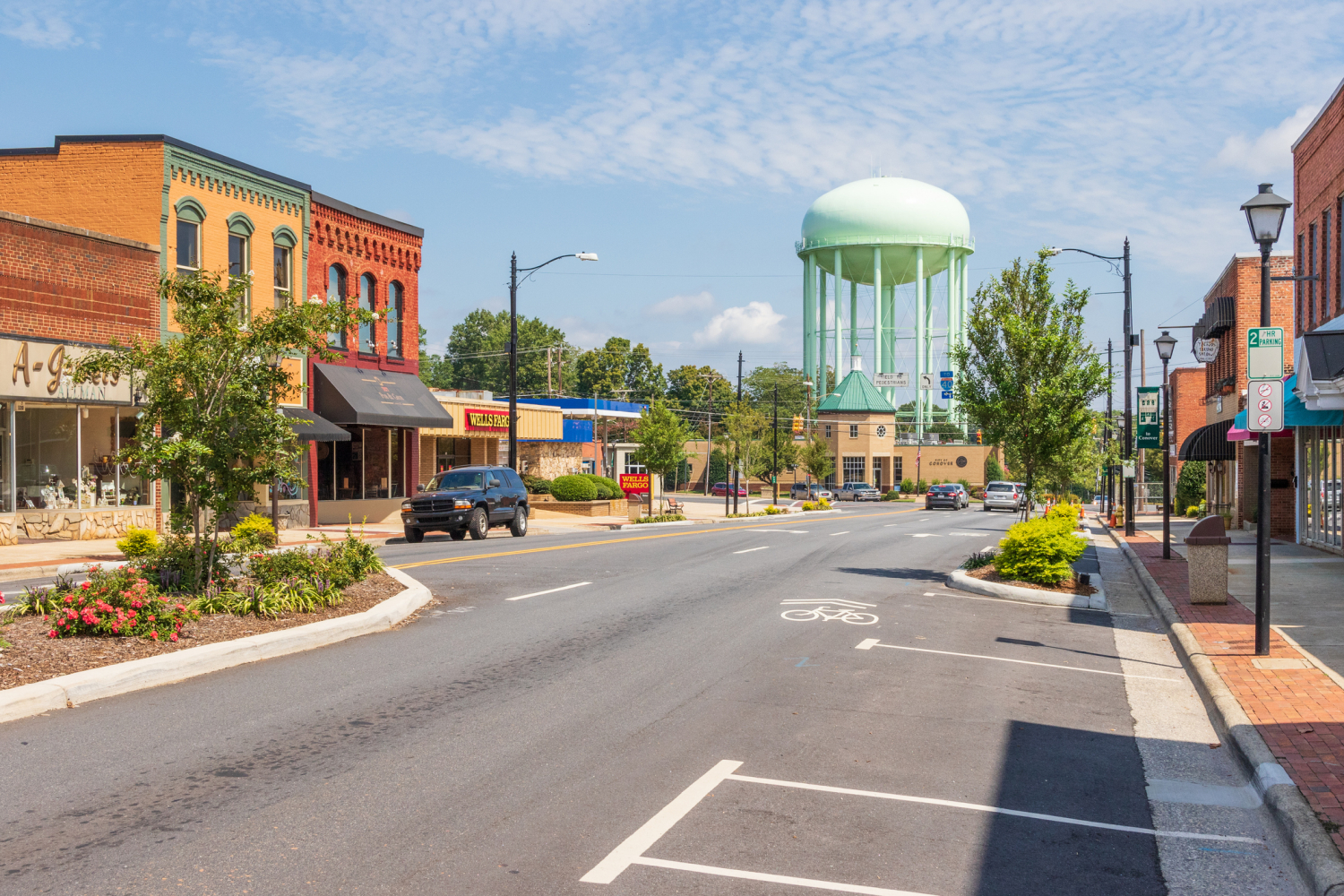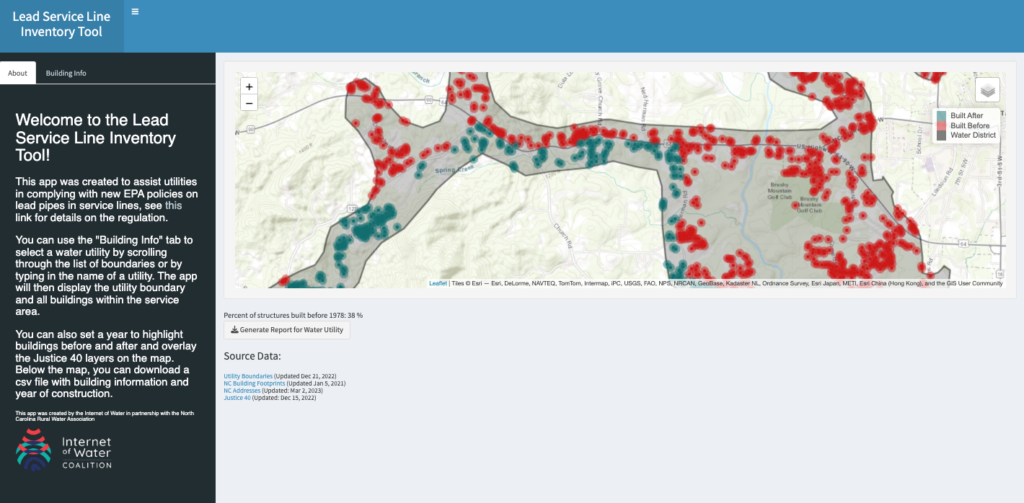Free Mapping Tool Will Help Small NC Towns Meet Water Quality Requirements

The world is digitized. From data to images to maps, they can be found in a digital format. One NC group is working to make that true for NC’s water utilities boundaries.
A collaborative research team led by Duke University’s Nicholas Institute for Energy, Environment & Sustainability is working to lessen the digital divide for small rural water utilities and help them fulfill reporting requirements. With funding from the NC Water Resources Research Institute, they have developed a free mapping tool called BoundarySync as part of the Internet of Water (IoW) project.
Digital boundaries can readily define service areas, showing which properties are fed by certain water systems. Having an easily accessible and current boundary map allows utilities to quickly answer simple customer questions like “Are you my service provider?” But also, having a digital map of their service area boundaries makes it easier for utilities to perform analyses of demographic and other information, which are often required for state and federal funding applications. Additionally, it can help utilities better understand their constituency, and the water quality of their watershed by making it much easier to overlay different kinds of data (census tracts, water quality data, etc).
Identifying the Problem
Despite the benefits of digitized boundaries, many utilities in North Carolina, particularly small rural utilities, rely on paper maps, images, a list of addresses, or in some cases no list at all. The lack of digitized boundaries presents a major barrier for local officials to use water data effectively. It also makes it nearly impossible for the state to conduct regional analyses about water supply and infrastructure.
“Better water data equals better water management,” says Lilli Watson, grant management and communications lead for the project. And the first step to better water quality is knowing where the water is coming from. So, in 2019, Duke researchers partnered with North Carolina Department of Environmental Quality (DEQ) to create digital service area boundaries for water systems serving more than 3,000 people.
However, for the newly digitized boundaries to be helpful, they must be regularly updated and maintained using mapping software, which most small-scale utilities lack access to.
Finding a Solution
With the support of funding from NC WRRI, in 2021 the research team developed BoundarySync, an open source mapping tool designed for utilities to easily create, update, and maintain digital service area boundaries.
They worked closely with the North Carolina Rural Water Association (NCRWA) throughout the process to ensure the tool is easy to use and meets the needs of the target audience – small water utilities.
As such, it doesn’t require specific technical skills to use, and is free to access through an internet browser; no expensive software is needed. BoundarySync is the first of its kind, providing every community water system in the state free and easy access to digitally map and update their service area boundaries.
“A total of 532 utilities’ service area boundaries can now be viewed and updated through BoundarySync, and the smallest systems that still lack digital boundaries are now able to create them with this easy-to-use tool,” explains Ashley Ward, the project’s principal investigator and engagement lead.
Maximizing Relevance
One thing the research team didn’t initially anticipate was that they’d have to convince small utilities of the tool’s value. When members of small teams are understaffed or juggling many projects, oftentimes the last thing they want to do is add something else to their plate.
But, new federal legislation provided an unexpected motivator: in December 2021, the EPA announced new lead and copper rule revisions requiring that all community water systems, regardless of size, develop an inventory identifying potential presence of lead within each service line connection by October 16, 2024. With this news, the research team got to work and created a dashboard to address this, making the tool directly responsive to water systems’ needs.
“This dashboard will reduce the time commitment needed to comply with the new legislation and lower the burden on small rural utilities,” explains Watson.“ It also includes data identifying disadvantaged communities eligible for financial benefits as part of the Justice40 Initiative.”

The NCRWA is diligently working to spread the word to help small systems understand what’s going to be involved and provide them with resources to meet the requirement, but the clock is ticking.
“We’re slightly over a year from the deadline, and there’s still systems that are unaware of exactly what’s going to be required of them to meet that deadline,” says Brian Grogan, executive director of the NCRWA.
“BoundarySync will be a key resource in this effort,” Grogan continues. “The way it’s set up now, you can do a search based on the year structures were built to focus your efforts on structures built before the lead ban.”
“It’s important for research to address real world needs. The collaborative and adaptive approach used in this project resulted in a tool that can immediately benefit small water utilities.”
– Kaitlin Tucker, WRRI’s coordinator for research and engagement
Reaching Beyond North Carolina
The digital divide is not just an issue for North Carolina’s utilities.
“At least 10,000 water systems in the country currently have no way of digitizing service area boundaries,” explains Kyle Onda, director of the Internet of Water Initiative at the Lincoln Institute’s Center for Geospatial Solutions, and technical lead on the project.
Onda is currently working with Oregon and California state agencies to adopt this tool. He hopes it can be something many more states find useful.
“Because we’ve made the software open source and available on GitHub, anyone can download and adapt BoundarySync to their own needs,” he says. Additional potential applications include digitizing wastewater and stormwater boundaries, land conservancy districts, or irrigation district boundaries.
Ongoing Challenges for Rural Utilities
The initial aim of this project was to provide a tool to support small utilities and enable regional and statewide planning. Throughout the process, however, it evolved into something bigger.
“Over the course of this project I learned a lot about how small utilities function. They’re often run by very small teams who are working really hard and have a lot to handle. [BoundarySync] is one small technical thing that will be helpful in a few areas, but there’s no single solution to address the challenges that small utilities face,” says Watson.
The Internet of Water team at Duke created an informational video that highlights the work the NC Rural Water Association is doing to build technical capacity, and emphasizes some of the challenges unique to rural, small utilities.
Regardless of access to new and beneficial tools, the primary challenge facing small utilities is capacity, emphasizes Grogan. “Over 50% of operators will retire in the next 10 years,” and systems are required to have a certified operator to run, he notes.
New impending legislation limiting the amount of PFAS in water systems is aimed at protecting the public, but it also presents an added challenge for the industry, especially for small, rural systems.
“A lot of these systems are a one man show; they wear a lot of hats, it’s not just dealing with water or wastewater–typically they’re doing both. Plus they’re maybe doing trash pickup, putting up Christmas lights, whatever needs to be done…It’s difficult for them to put everything down and focus on something that can be as complex as dealing with emerging contaminants. That is the challenge.”
– Brian Grogan, NC Rural Water Association
Although utility workers wear many hats, providing drinking water is an important responsibility they don’t take lightly.
“[Utilities workers] feel a responsibility toward their communities to provide safe drinking water and disposal of wastewater and they pride themselves in doing that. Having safe drinking water is the foundation of our communities.”
BoundarySync is now available and freely accessible to North Carolina utilities through the NCRWA. General information on the tool is available to the public via the Internet of Water Coalition’s BoundarySync webpage. Interested water systems across the country can reach out via the Internet of Water Coalition website to explore how BoundarySync might benefit them.
Lead image: 93% of community water systems in North Carolina serve small towns with populations of 10,000 or less, like this one in Conover, NC. Photo by J. Michael Jones via iStock.
- Categories: